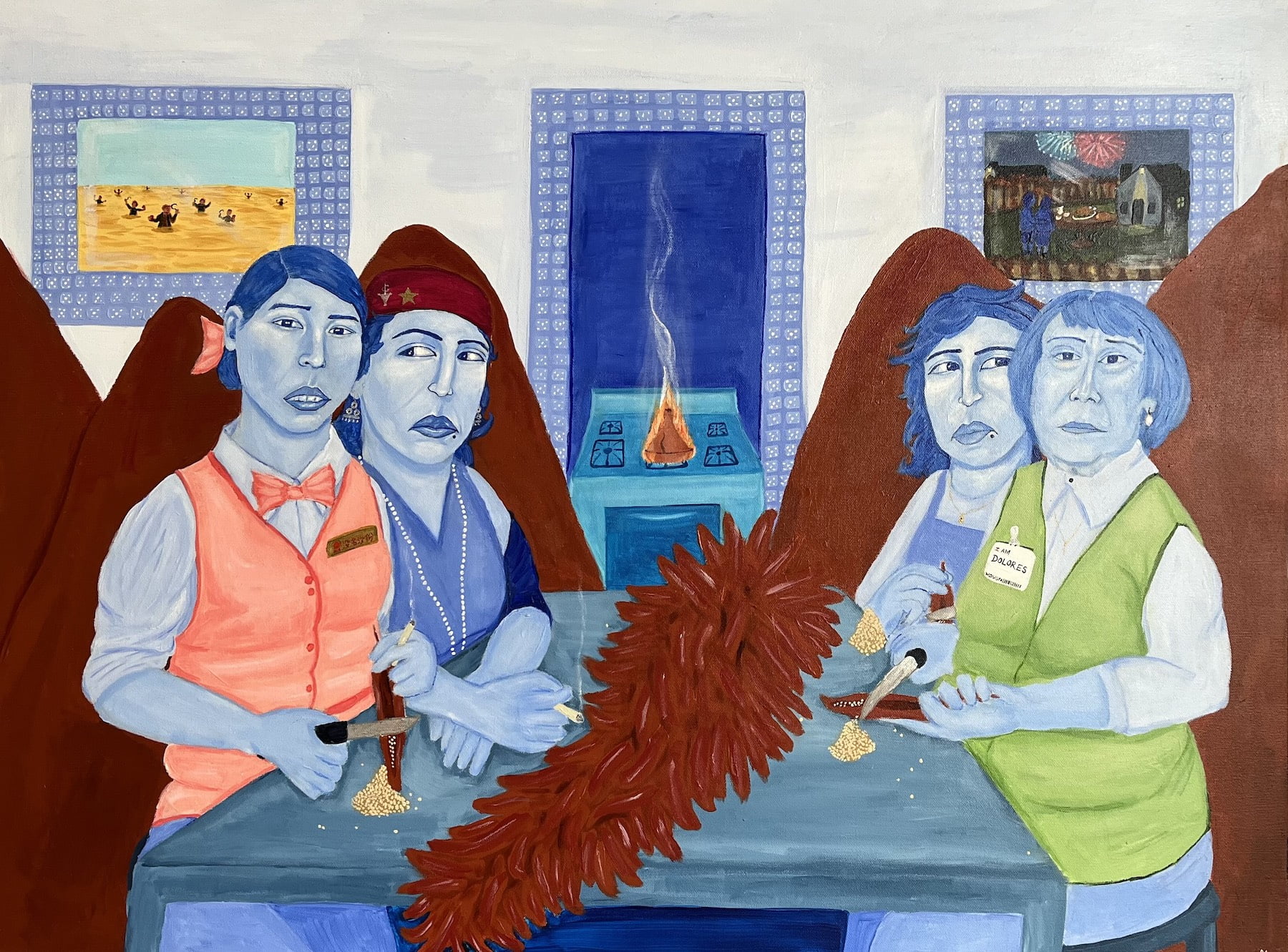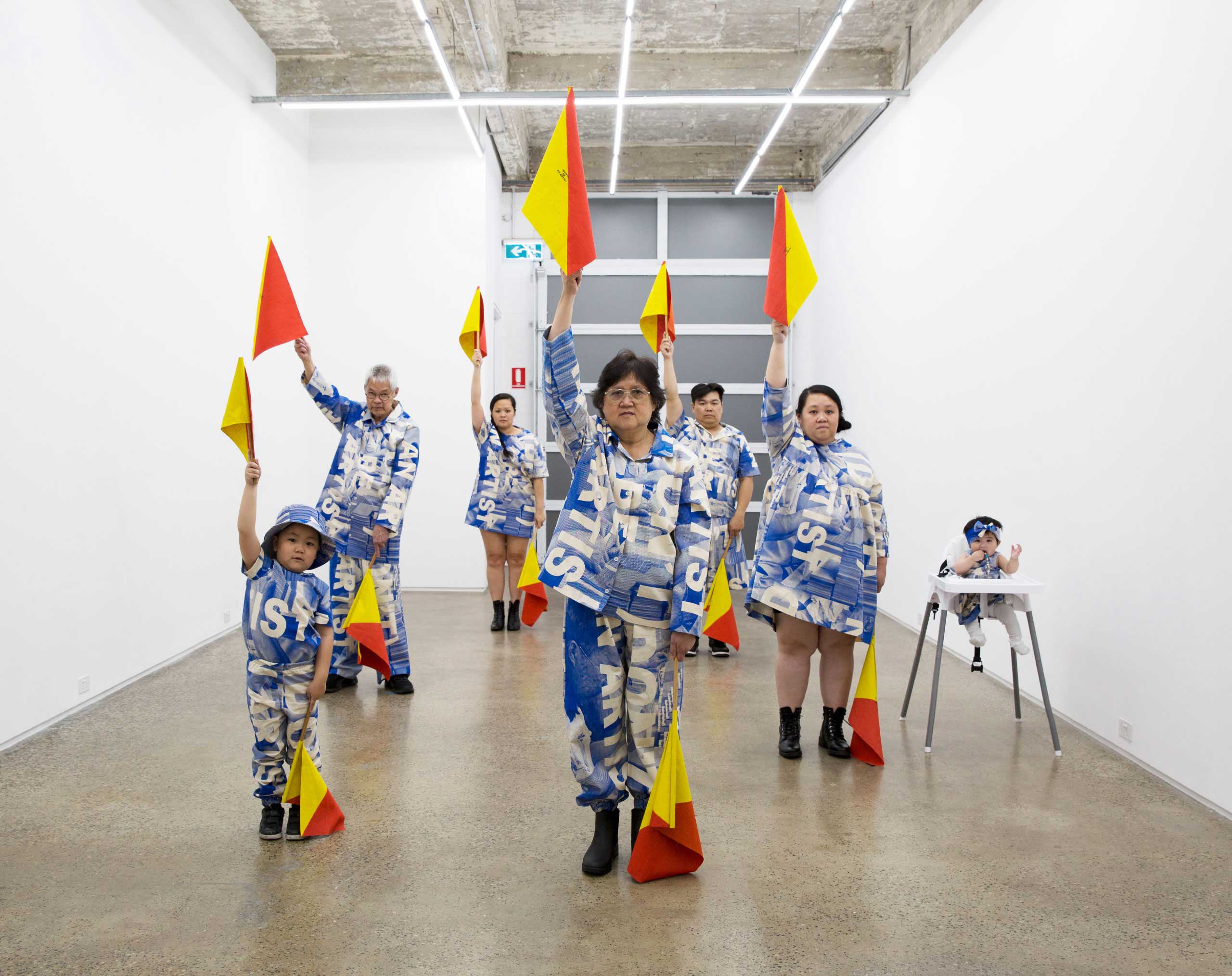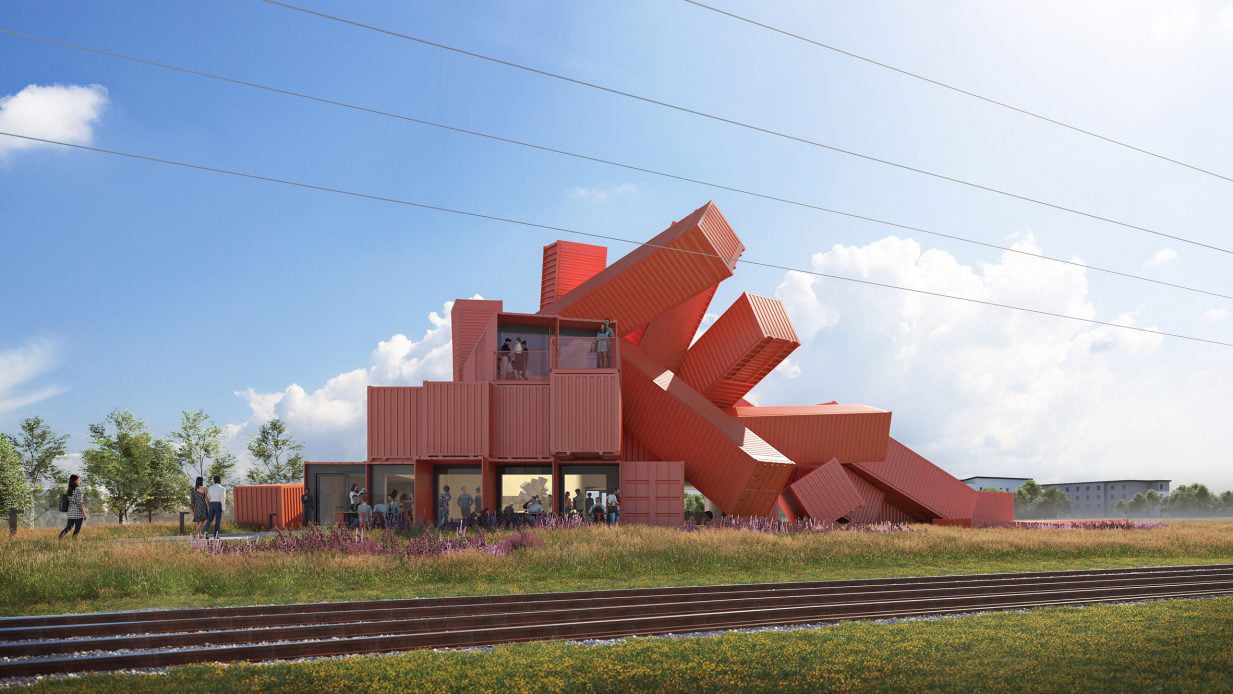
David Mach – Heavy Metal
When it comes to art making, does size actually matter? If you ask David Mach, the answer can only be yes – it certainly does.
His name synonymous with the sheer, epic monumentality that distinguishes much of his work, Royal academician and Turner Prize nominee David Mach has pushed the envelope of installation art by redefining the possibilities of size and scale in the genre for almost four decades.
Tireless with experimentation – his diverse use of materials has ranged from coat hangers, pins and matches, to bricks, magazines and shipping containers – Mach rose to prominence in the early 80s with a number of boldly ambitious installations that sat at the intersection between sculpture and architecture.
Amongst his most remarkable works are: Polaris (1983, Southbank, London) – a life-size representation of a nuclear-powered submarine made from tyres; Out of Order (1989, Kingston-upon-Thames, Surrey) – 12 red phone boxes leaning against one another like a set of dominoes; Here to Stay (1990, Tramway, Glasgow) – a series of giant classic pillars built from old Herald newspapers; Temple at Tyre (1994, Leith Docks, Edinburgh) – a Parthenon-inspired temple made from 8,000 tyres sitting on a stack of containers overlooking the sea; Brick Train (1997, Darlington) – a 23 ft high and 95 ft long steam locomotive built using 185,000 Nori bricks.
With exciting new projects and commissions on the horizon – including a library for Antioch University in Damascus, a giant sculpture for Chiswick Roundabout in London, and Mach1, an arts, events and conference venue to be built in Edinburgh Park using 30 shipping containers – David Mach and his art have never been more relevant.
Opening on January 25th, Heavy Metal is Mach’s new exhibition at Pangolin London.
Promising to be a must-see for all installation enthusiasts, the show will bring together several maquettes for new pieces, large scale prints and bronzes referencing two of his past commissions – namely Temple at Tyre and Darlington’s Brick Train – to provide a unique insight into the practice and creation process of one of the most significant and influential British artists of his generation.
Ahead of the opening of Heavy Metal, 1883 Arts Editor sat down for a chat with David Mach to discuss his work and ask about his future artistic ambitions.
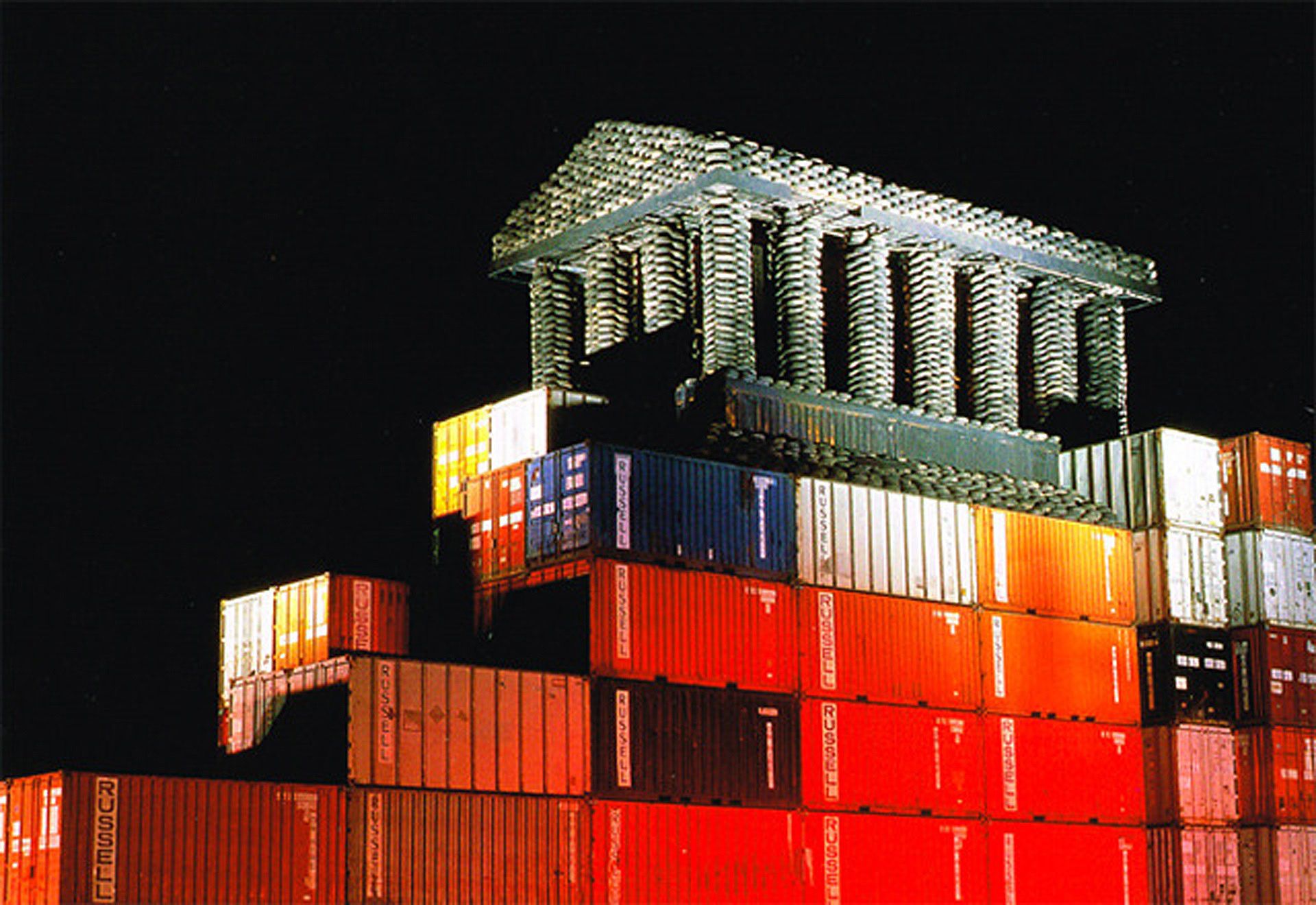 David Mach, The Temple at Tyre, 1994, Installed in Leith, Edinburgh
David Mach, The Temple at Tyre, 1994, Installed in Leith, Edinburgh
Thank you for agreeing to the interview
Can you tell us a bit about your upcoming exhibition at Pagolin London? What can we expect from the show?
The Pangolin London show has been some time coming. We considered a variety of things – an installation, individual sculptures, 100 collages spread throughout the building, but we’ve settled on an exhibition of some 15 to 20 maquettes and models, collage, prints and drawings of new sculpture and architecture, the full size version of each of these to be completed over the next few years. It’s an important show for me.
It will let an audience see what I have been and will be up to, how my exploration of materials and their use has changed and expanded over the years and how the scale of my work has continually expanded to break into giant projects pushing exciting engineering with challenging structures that have literally never been seen before.
We’re presenting, Pangolin and I, these works in a way that explains their size and scale, the objects and materials they are made off and the efforts gone to, to make their construction real.
You’ll recognise everything I use, everything you’ll see is already in your life. I hope you’ll be excited.
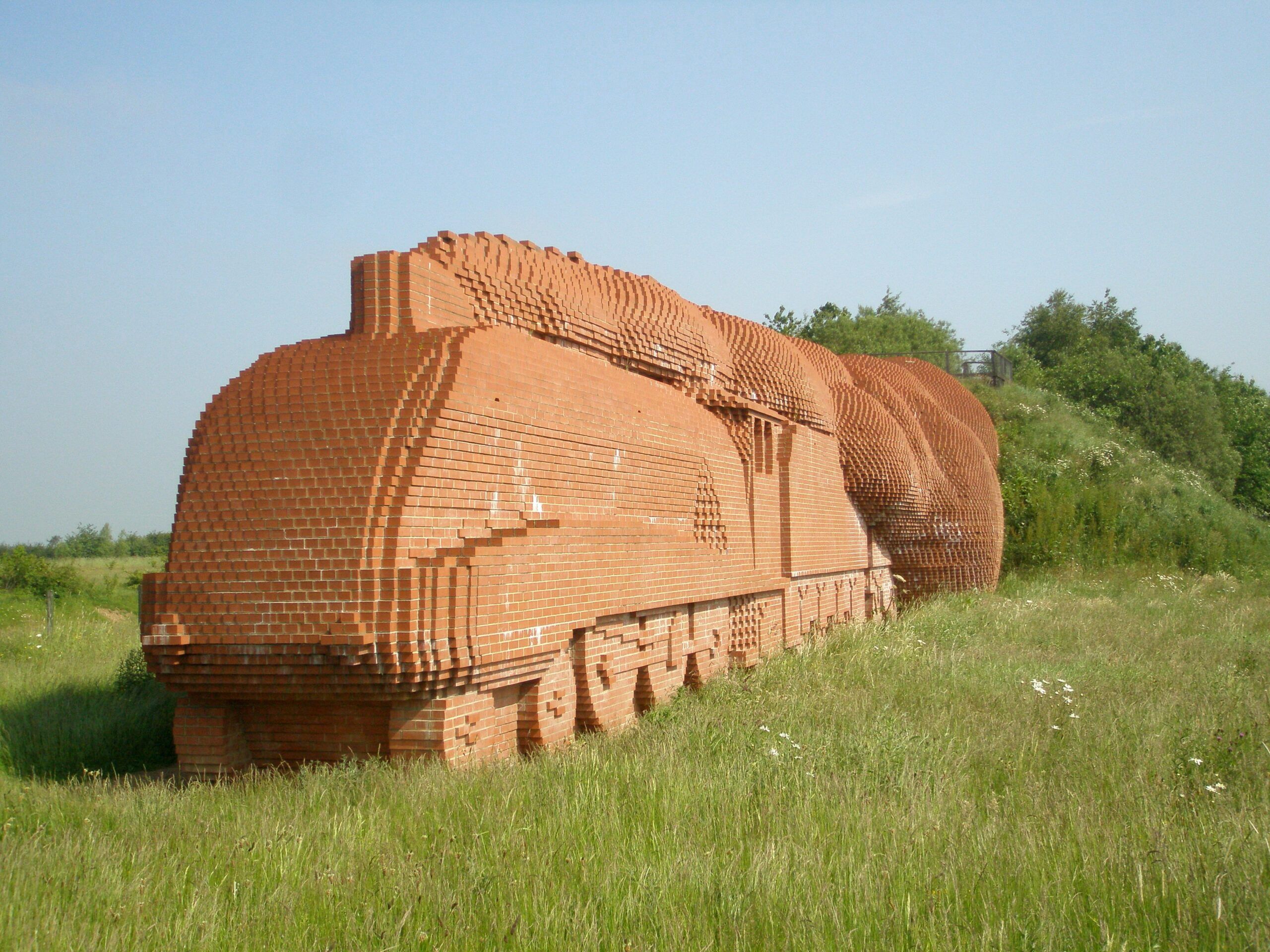 David Mach, Brick Train, Darlington, 1997
David Mach, Brick Train, Darlington, 1997
Your works are made with materials as varied as coat hangers, pins and matches. Do you have a preferred material to work with?
I’ve used an awful lot of materials and objects in my sculptural life, 100’s of tonnes of newspapers, magazines and tyres, thousands of coat hangers, millions of pins, matches, nails and screws. I’ve played with Barbie and Sindy dolls, teddy bears, containers, boats, cars and trucks. I’m unbelievably greedy for ‘stuff’ to play with and in large unfeasible and extravagant amounts.
My current favourite I must confess is Sea Containers. Just a heavy, metal box but so inspiring, the Sea Container must be one of the most significant objects of our 21st Century. It has a substantial impact on our lives. Almost anything you can buy, furniture, cars, washing machines, fridges, anything, is destined to be shaped and sized to fit inside it and then be transported to and from any destination in the world. These boxes hold everything. Truly global, they go out into the world taking their goods with them, completely International, emissaries of peace and negotiators of trade.
They are ‘Brute’ in design but still an object I can use, not only intimately, constructing inside and around it delicately and rhythmically but as a massive building block that gives me access to giant construction.
These boxes come with their own lore, their own legend. Sailors fear them! Sea Containers fall off ships to become lethal unavoidable icebergs floating just a few feet below the waves. They’ve fallen from aeroplanes too, into the Amazonian jungle, local Tribes finding them. They worship them as if they were the obelisk in 2001: A Space Odyssey.
They’re classical in proportion, like Greek temples with their long-ribbed sides for strength and their short square ends for entry and exit. They are like an icon, the Marilyn Monroe, the Chairman Mao, the Che Guevara of the global highway.
How does scale come into play with your work?
My natural inclination is to be extravagant. In a world that wants us to be cautious, careful, reasonable, I don’t want to be conservative, I want to be dramatic and extravagant and that often leads to very large works but can include the building and construction of small, even tiny sculptures. The smallest sculpture I ever made sat in the ashtray of a Hillman Imp, 6000 miniature tyres forming up a Greek Temple an inch long sitting on a pile of ash and fag ends.
The sculptures I make with matches, 30-40,000 of them in the construction of just one, involves that extravagance in effort, in days and weeks of work, in numbers and amounts of material. They’re still small, so not everything I make turns out big.
Perhaps there is a reality to the scale I employ. A human scale, a recognisable one that helps an understanding of the sculpture I make and of course, I’m using highly recognisable materials. Matches, magazines, tyres, containers etc. They not only all come with their own recognition factor, you know them for what they are, what they’re made of, and they have their own declared scale.
As a viewer you even know when that scale has been altered, enlarged, or reduced. You know when you’re looking at a scale model or a blown-up version of something. That’s human and I like to use that knowledge as a draw, as something that pulls in an audience to have a look.
What goes into consideration when making a large-scale, site-specific installations such as, for instance, Polaris, Adding Fuel to the Fire or Temple at Tyre?
Installations depend on time pressure, deadlines, and sites, not to mention the idea that’s being worked on. Working under pressure is essential to shifting, manoeuvring, modelling hundreds of tonnes of material and where the site is, what it is, what size it is, how much volume do I have to play in, can I interfere with the space, knock things down, shift walls, dig holes, etc.
I’ve installed in nightclubs, parks, a brothel, in a swimming pool, in a moving tube train, as I said in the ashtray of a Hillman Imp (I think it belonged to Jarvis Cocker) and many more spaces. I try to push the limits of the space, the site as much as possible. I have to tell you; galleries and museums are the most boring and limited places to work in. It should be the other way round, of course, but preciousness has taken over in our art institutions.
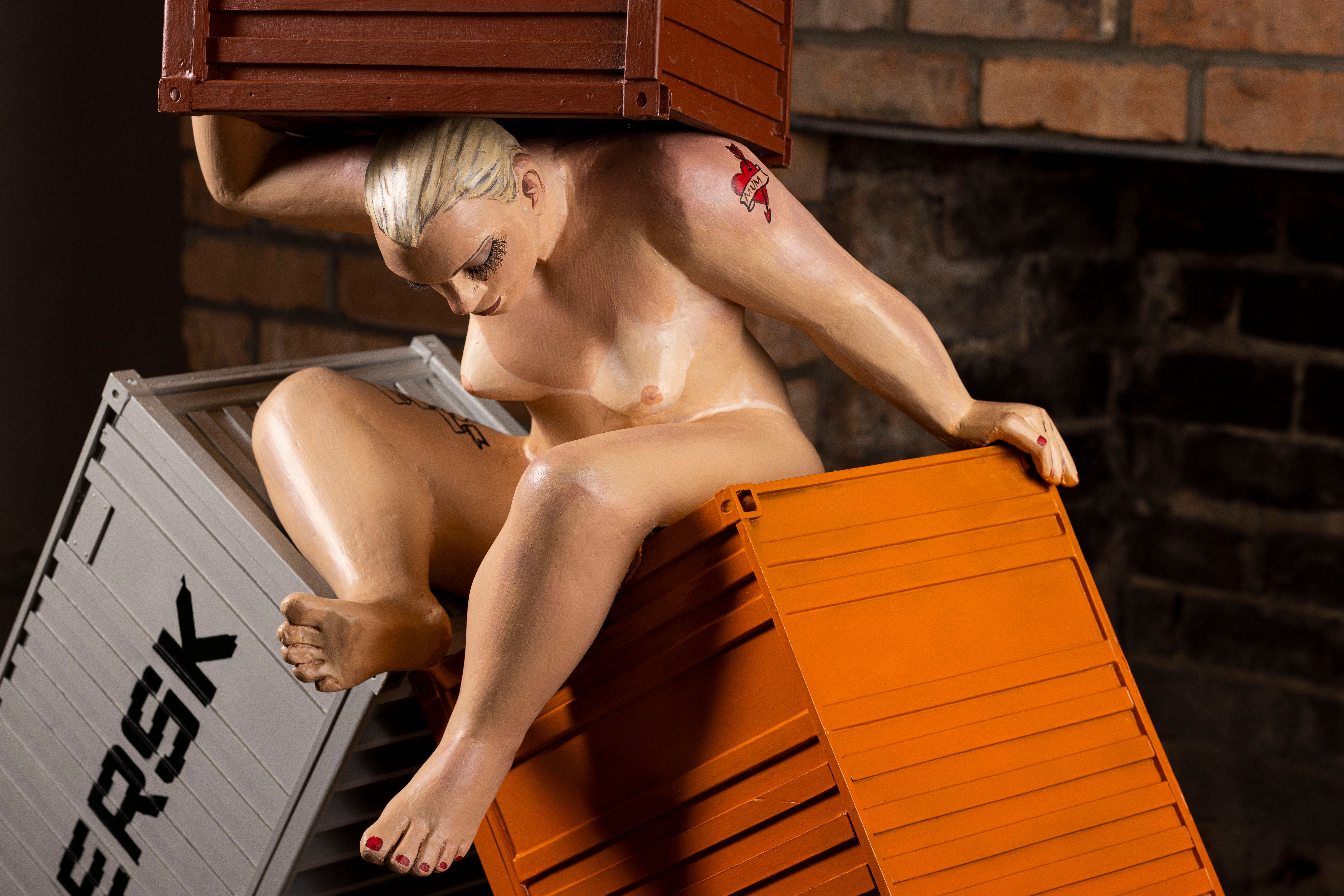 David Mach, Caryatid Easy maquette, Photo by Duncan McGlynn
David Mach, Caryatid Easy maquette, Photo by Duncan McGlynn
How do you approach a new work? What is your creative process like?
Depends what I’m working on – there’s always a preamble, smoking fags, drinking tea, and sweeping the floor but that doesn’t last long now. I’ve probably waited far too long to start the job, pressuring myself to crack on and bearing in mind I go from one job to the next constantly I live in an atmosphere of looming deadlines.
Apparently, I need that push. I’m not panicked, not under stress, not worried, I just enjoy the push. I think I definitely get better results with that attitude, being in that state and it suits my over-inspired, frantic collection of ideas, all needing to be produced for sculpture, for collage and for music and writing and I’m obsessed with new ideas. I want them, I need them, so the creative process in my head never stops.
I’m constantly working out how to make something, considering what processes I need to use, especially with new ideas, how big it needs to be, how long, how high, you name it, I’m thinking about how possible it is to make this new thing. That’s fun for me and involves adventures in building and engineering and meeting people who doubt that thing can be made like that. I like taking that kind of thing on.
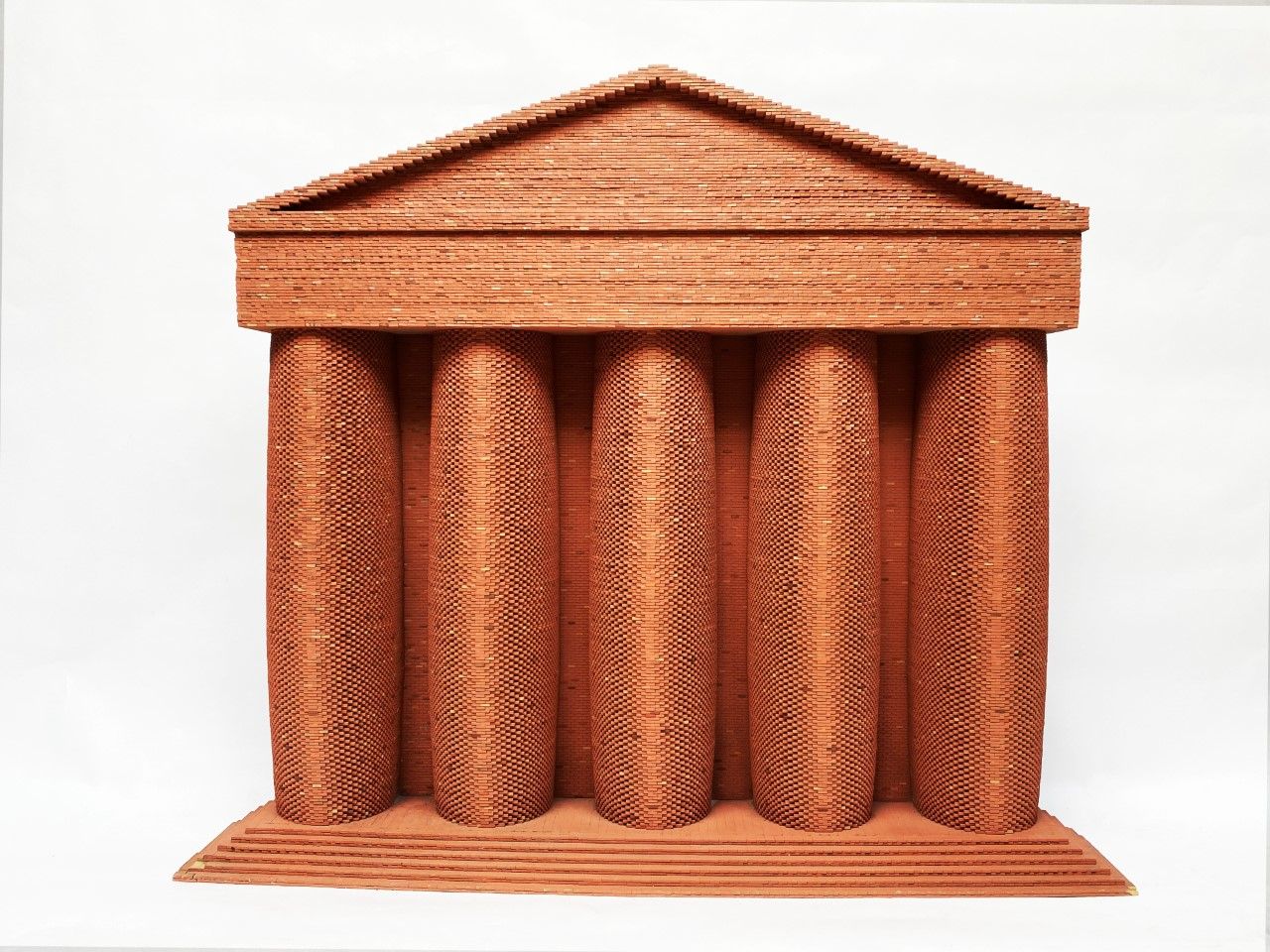 David Mach, Temple of bricks, maquette, 935x1110x180mm
David Mach, Temple of bricks, maquette, 935x1110x180mm
What do you want the viewer to take away from your art?
I want the hairs on the back of the neck of anybody looking at my work to stand right up. I want their eyes googling, eyebrows arched.
I want them to burst into tears. I want them to giggle hysterically. I want their heart beating faster, their minds stimulated, and their stomach tingling and I want them to reach for their wallets, cheque-books and credit cards and to throw money at me whilst patting me on the back and applauding. That’s what I want!
If I may ask , what are your future plans in terms of works and further exhibitions?
The future is very exciting. I’m becoming involved in not just large projects but massive operations the size of cities. Ideas so grand, so big I’ve begun writing books, novels about them as I try to work out just how to make them in the first place. These ideas are coming at me thick and fast.
They’ll require an extraordinary amount of work, of creativity, of know -how yet to be discovered. They’ll require teams of assistants, crazy investments in money, time, materials and belief. You need to believe in your ideas and you need other people to come in behind with that same belief so you need to inspire and drive everything on.
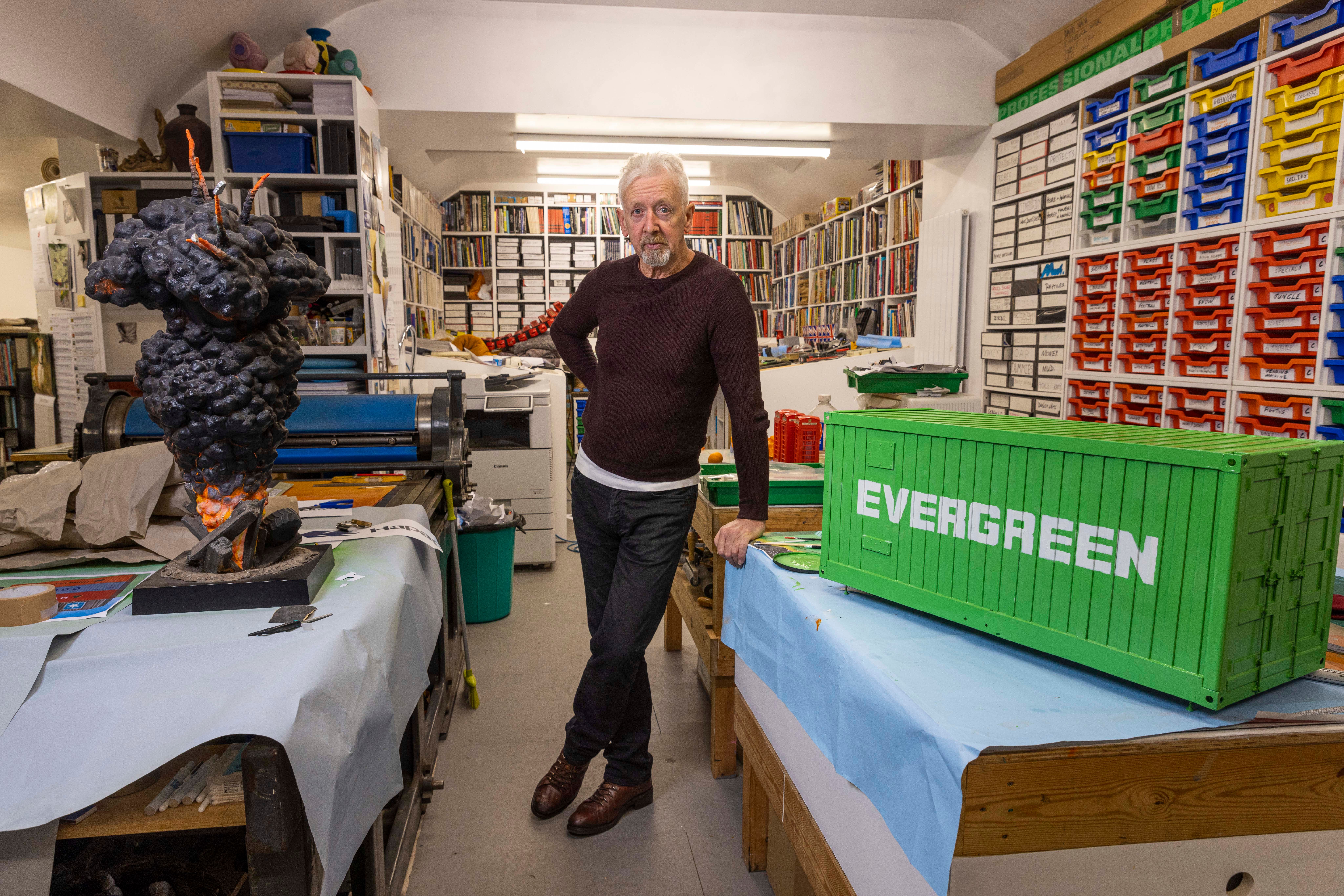 David Mach in the studio, Photo by Duncan McGlynn
David Mach in the studio, Photo by Duncan McGlynn
Heavy Metal will be running from 25th January – 25th March, at Pangolin London, Kings Place, 90 York Way, London N1 9AG
Featured Image: Render for Mach1, Edinburgh Park, Courtesy of Mach, Edinburgh Park and Dixon Jones
Words and interview by Jacopo Nuvolari



